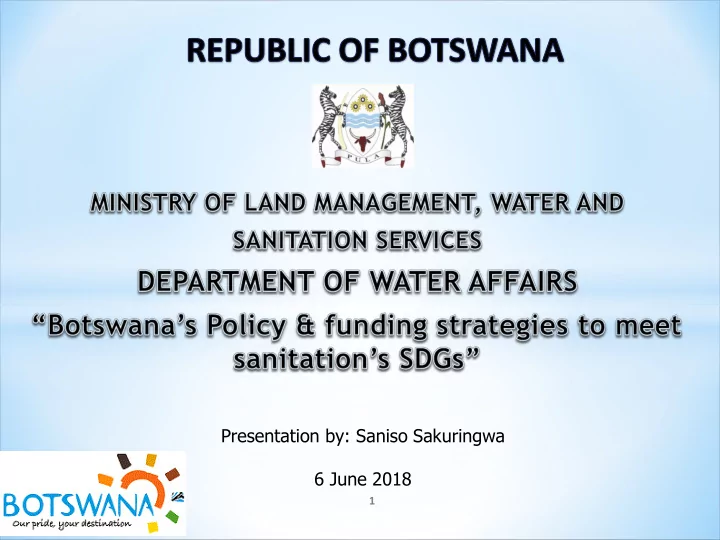

Presentation by: Saniso Sakuringwa 6 June 2018 1
• Introduction • Overview of water sector (water & sanitation) • Legislative framework & Policies • Current Situation • Challenges • Successes
• Botswana is a water scarce country and relies heavily on groundwater as a source of potable water for most of the population • Population 2.00 M (2011 Census) • 97% of the population has access to potable water while 64% has access to sanitation • The National Water Master Plan Review of 2006 recommended a number of policy and institutional reforms to the water sector in Botswana. • Among other things, the water sector reforms (2008- 2014) required the transfer of the water supply function from The Department of water Affairs (DWA) to Water Utilities Corporation (WUC) 3
• The Mandate for Sanitation has been recently transferred to MLWS_DWA is responsible for sanitation ( planning & Policy formulation) • WUC is responsible service delivery (both onsite & offsite)
Legislative Frameworks Key frameworks that address Water and Sanitation governance are; • Botswana National Water Master Plan Review of 2006. First introduced in 1991 and became Governments water bible in terms of water management, planning and development. Policy Statement with regards to water supply and sanitation: Safe, affordable and reliable water and sanitation must be provided to all the people of Botswana to promote a healthy population and provide the foundations for sustainable economic development and diversification.
National Water & Wastewater Policy Cont.. Policy Objectives • To accelerate the provision of access to safe, affordable and reliable water and sanitation services to all in Botswana. • To ensure the long-term financial sustainability of potable water supply and wastewater services. • To promote social equity in access to water supply and sanitation services with protection for the destitute and the vulnerable. 6
National Water & Wastewater Policy Cont.. Some of the Strategies adopted by the National Water Policy are; • Safe, affordable and reliable water and sanitation must be provided to all the people of Botswana • Transfer responsibility for all water service delivery and sanitation services in gazetted settlements to the Water Utilities Corporation. • Increase the inclusion of recycled water to 96 % by 2030 in line with National Master Plans • Promote the investment in water supply and sanitation infrastructure • Develop and introduce quality and service standards along with community-based monitoring and performance evaluation mechanisms
• Waste Management Act 1998, • Public Health Act, • Environmental Assessment Act of 2011 • Water Act 1968 8
9
• Access to sanitation is 64% (81% urban & 62% rural) Distribution of Households by Type of Toilet Facility Others, 2,98% Own VIP, 1,83% Neighbours Pit Latrine, 4,62% Own Flush Shared Flush toilet, 25,24% Toilte, 8,60% None, 14,83% Shared Pit latrine, 18,23% Others Own-VIP Neighbour's Pit Latrine Shared Flush Toilet None Own Pit Latrine 10 Own Flash toilet
• National = 38% but rural areas over 90% • Water supply over 97 % access • Not a true picture…WHY? • Toilet infrastructure often not used or unusable • Interruptions to supply in smaller villages often for months • Poor WASH behavior despite relatively good WASH knowledge • OPEN DEFECATION IS STILL THERE ESPECIALLY IN RURAL AREAS
*
• Access to sanitation is 64% (2011 Census) (81% in urban areas and 62% rural area) Innovative Approaches • Coordinated planning at national level (thematic working groups) • Building partnerships with other institutions /NGO • DWA-SIWI partnership (institutional framework for optimised wastewater & sanitation resource management) • Wastewater recycling (effluent utilisation-used recycled water for irrigation and treated sludge for fertiliser) 13
• 1. Water and Sanitation Programme (Infrastructure) is aimed at optimization of the use of the existing water supply and sanitation network, and rehabilitation and extension of the network to achieve 100% coverage across the country. The improvement will enhance the efficiency of the existing infrastructure and reduce water losses. The programme will also positively impact on health and socio-economic aspect of the communities by reducing water borne diseases and enhancing environment for economic activities.
Planned NDP11 project covers villages of Maun, Kanye and Moshupa, implementation and Grey Water Recycling and effluent Utilization 2. Education and awareness campaigns (hand washing and Sanitation programme, school health clubs) 3. Monitoring of sanitation facilities in government 4. Surveillance inspections of wastewater generating and private institutions countrywide
5. National Rural Sanitation Programme (subsidy toilets- sub structure, then owner builds super structure) 6. Community Lead Total Sanitation Programme
• General underinvestment in the Sanitation sector (need to rope in Private sector) • Full cost recovery through tariff is too much for the users especially rural dwellers (Tariffs do not cover the full costs of operations and maintenance) • No dedicated programmes in place aimed for improving sanitation in rural areas • Major centralised sewer infrastructure is mainly planned for urban and major villages • Lack of operation & maintenance of sanitation facilities (financial & human resource) • Poor project implementation leading to cost escalation • Lack of coordination (Too many role players in the sanitation sector; Local Government, WUC,DWA, Public Health) 17
• Access to improved sanitation stands at 64% • Following National Rural Sanitation Programme a lot of households have access to onsite sanitation 18
THANK YOU FOR YOUR ATTENTION 19
Recommend
More recommend